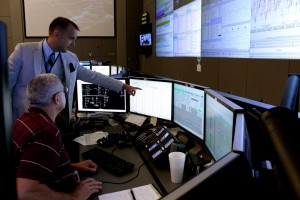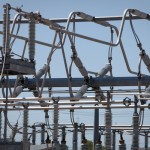Why Texans Are Using Less Energy Than Expected

Photo by Filipa Rodrigues/StateImpact Texas
Controllers make daily forecasts of the next day’s electric demand and supply down to every five minutes.
Texans have lived for years with a looming energy crisis. Experts always saw it on the horizon and warned, periodically, of its arrival. The state was growing, they observed, and the electricity supply was not keeping up. When the reckoning came, it would come in the form of rolling blackouts. Such predictions often yielded reporting like this (by yours truly).
Then, this month, things stopped looking so bad.
The news came as the Electric Reliability Council of Texas (ERCOT) released its annual forecast of how much electricity Texas will have in the coming years. ERCOT has traditionally warned that, in the future, there may not be enough energy on reserve during times of peak use, like hot summer days. This year, the message was different.
“Our view is that the growth in peak hour demand on hot summer afternoons will not be as strong as we had forecasted in the past,” Warren Lasher, ERCOT director of System Planning, told reporters on a Friday press call.
What changed is not the just amount of energy available (that’s growing, but slowly), it’s the fact that Texans’ electricity use has stopped rising with Texas’ economic growth. What’s behind it?
”We’ve been noticing a ‘decoupling,’ if you will, or a separation in the growth of demand compared to how it would track with any economic variable,” Calvin Opheim, manager of Load Forecasting and Analysis, said. “So our new model does a better job of reflecting that separation.”
And why are Texans using less energy than the experts thought they would?
For one thing, Texas is moving towards greater energy efficiency. Opheim said in some cases that’s because they’re required to, citing example of upgrading AC units to a higher efficiency standard this year. But also because they want to save money.
“You could have a person like my neighbor who went and changed all his lighting out on his house (to more efficient bulbs),” he said. “Obviously the amount of power they’re using on peak is reduced.”
Conservation also played a roll, and some of that may be a silver lining from the country’s recent economic downturn.
“When times are tough, people make changes in their behavior. And they actually reduced the amount of energy they use. They had to, they had impacts on their budget,” Opheim said. “But then when times picked up, they had learned these new behaviors and they retained their more efficient use of energy.”
One other way Texans are conserving: demand response.
As we’ve reported in the past, there is a growing number of programs that offer consumers money or other benefits for agreeing to have their AC turned down during times of peak demand.
